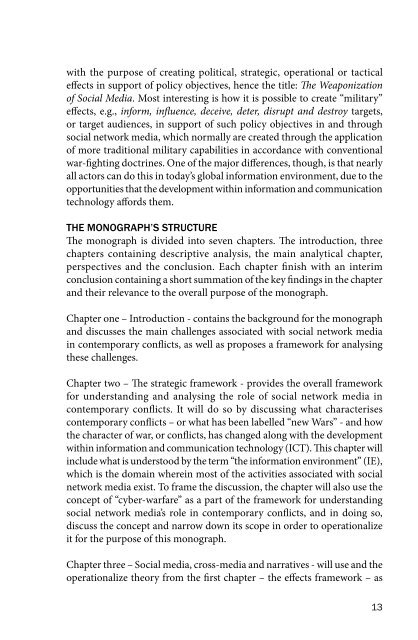The Weaponization of Social Media
The Weaponization of Social Media
The Weaponization of Social Media
Create successful ePaper yourself
Turn your PDF publications into a flip-book with our unique Google optimized e-Paper software.
with the purpose <strong>of</strong> creating political, strategic, operational or tactical<br />
effects in support <strong>of</strong> policy objectives, hence the title: <strong>The</strong> <strong>Weaponization</strong><br />
<strong>of</strong> <strong>Social</strong> <strong>Media</strong>. Most interesting is how it is possible to create “military”<br />
effects, e.g., inform, influence, deceive, deter, disrupt and destroy targets,<br />
or target audiences, in support <strong>of</strong> such policy objectives in and through<br />
social network media, which normally are created through the application<br />
<strong>of</strong> more traditional military capabilities in accordance with conventional<br />
war-fighting doctrines. One <strong>of</strong> the major differences, though, is that nearly<br />
all actors can do this in today’s global information environment, due to the<br />
opportunities that the development within information and communication<br />
technology affords them.<br />
THE MONOGRAPH’S STRUCTURE<br />
<strong>The</strong> monograph is divided into seven chapters. <strong>The</strong> introduction, three<br />
chapters containing descriptive analysis, the main analytical chapter,<br />
perspectives and the conclusion. Each chapter finish with an interim<br />
conclusion containing a short summation <strong>of</strong> the key findings in the chapter<br />
and their relevance to the overall purpose <strong>of</strong> the monograph.<br />
Chapter one – Introduction - contains the background for the monograph<br />
and discusses the main challenges associated with social network media<br />
in contemporary conflicts, as well as proposes a framework for analysing<br />
these challenges.<br />
Chapter two – <strong>The</strong> strategic framework - provides the overall framework<br />
for understanding and analysing the role <strong>of</strong> social network media in<br />
contemporary conflicts. It will do so by discussing what characterises<br />
contemporary conflicts – or what has been labelled “new Wars” - and how<br />
the character <strong>of</strong> war, or conflicts, has changed along with the development<br />
within information and communication technology (ICT). This chapter will<br />
include what is understood by the term “the information environment” (IE),<br />
which is the domain wherein most <strong>of</strong> the activities associated with social<br />
network media exist. To frame the discussion, the chapter will also use the<br />
concept <strong>of</strong> “cyber-warfare” as a part <strong>of</strong> the framework for understanding<br />
social network media’s role in contemporary conflicts, and in doing so,<br />
discuss the concept and narrow down its scope in order to operationalize<br />
it for the purpose <strong>of</strong> this monograph.<br />
Chapter three – <strong>Social</strong> media, cross-media and narratives - will use and the<br />
operationalize theory from the first chapter – the effects framework – as<br />
13



